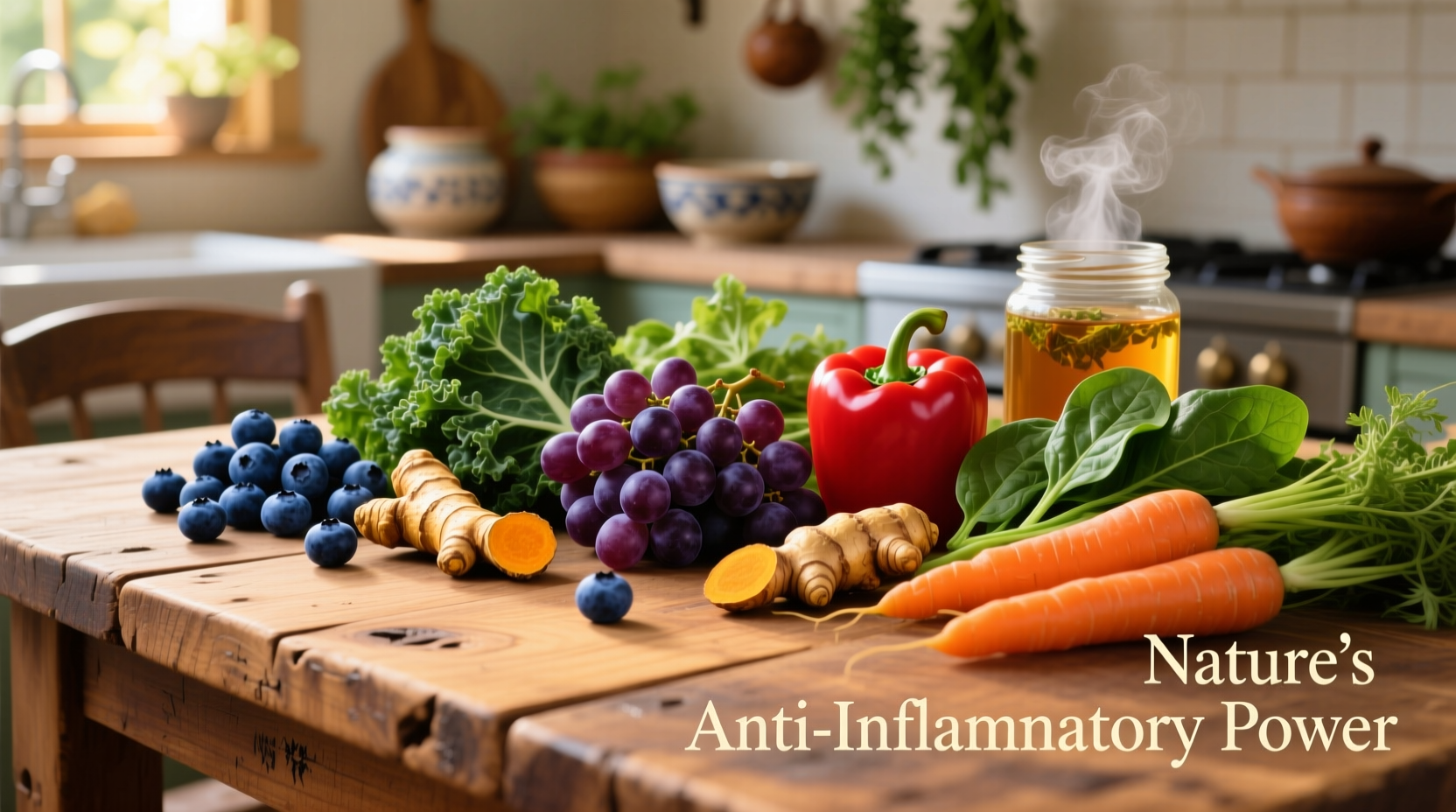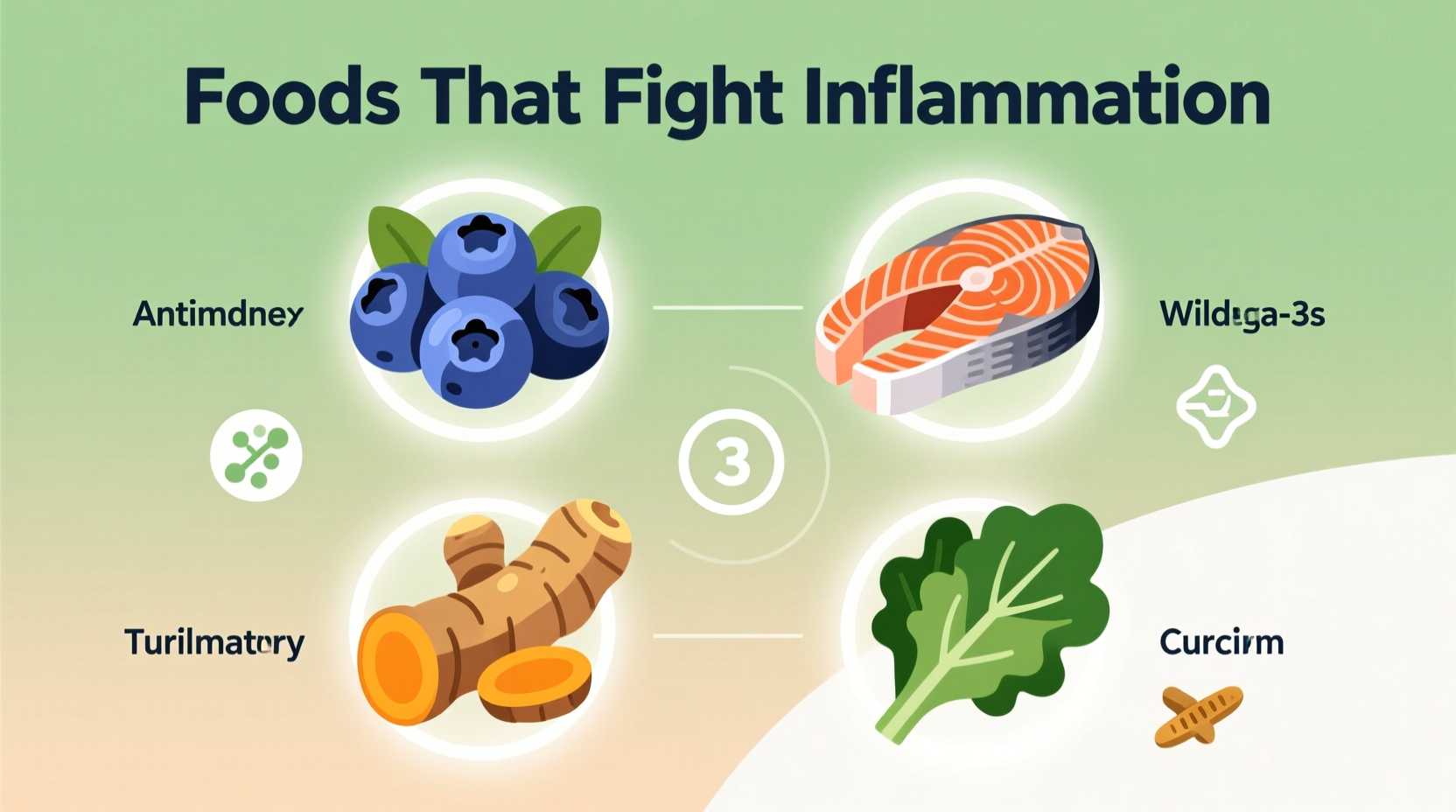Based on current scientific evidence, the most effective anti-inflammatory foods include fatty fish rich in omega-3s (salmon, mackerel), berries packed with antioxidants, leafy greens like spinach and kale, extra virgin olive oil, nuts (particularly walnuts and almonds), turmeric (especially when combined with black pepper), and green tea. These foods contain compounds that actively reduce inflammatory markers in the body when consumed regularly as part of a balanced diet.
Chronic inflammation silently contributes to numerous health conditions, from arthritis to heart disease. The good news? Your kitchen contains powerful tools to combat this biological process. Understanding which foods genuinely help—and how to incorporate them effectively—can transform your approach to wellness without relying solely on medication.
Your Anti-Inflammatory Food Roadmap
When inflammation becomes chronic, it's like having a fire burning inside your body that never goes out. Unlike acute inflammation (your body's normal response to injury), chronic inflammation requires dietary intervention. The Mediterranean diet consistently ranks as one of the most effective eating patterns for reducing inflammation, according to research published in The American Journal of Clinical Nutrition.
Top Evidence-Backed Anti-Inflammatory Foods
Fatty Fish: Nature's Omega-3 Powerhouse
Fatty fish like salmon, mackerel, and sardines contain EPA and DHA—omega-3 fatty acids that directly combat inflammation at the cellular level. A 2022 study in Circulation found that consuming fatty fish twice weekly reduced C-reactive protein (CRP), a key inflammation marker, by 15-20% in participants. For optimal benefits, choose wild-caught varieties prepared by baking or steaming rather than frying.
Berries: Antioxidant Champions
Blueberries, strawberries, and blackberries contain anthocyanins—potent antioxidants that reduce inflammatory markers. Research from the USDA Human Nutrition Research Center shows that consuming one cup of mixed berries daily for eight weeks significantly lowered IL-6 and CRP levels. The fiber content in berries also supports gut health, which plays a crucial role in systemic inflammation.
Extra Virgin Olive Oil: Liquid Gold
Unlike refined olive oils, extra virgin olive oil (EVOO) contains oleocanthal—a compound with effects similar to ibuprofen. A landmark study in Annals of the New York Academy of Sciences demonstrated that consuming 50ml (about 3.5 tablespoons) of high-phenolic EVOO daily reduced inflammatory biomarkers by up to 30%. Choose cold-extracted, early harvest EVOO stored in dark glass bottles for maximum potency.
| Food | Key Anti-Inflammatory Compound | Effective Daily Amount | Time to Notice Effects |
|---|---|---|---|
| Fatty fish | EPA/DHA omega-3s | 3.5 oz (twice weekly) | 4-8 weeks |
| Berries | Anthocyanins | 1 cup mixed varieties | 6-8 weeks |
| Extra virgin olive oil | Oleocanthal | 3.5 tbsp | 3-4 weeks |
| Turmeric | Curcumin | 1 tsp with black pepper | 8-12 weeks |
How to Maximize Anti-Inflammatory Benefits
Strategic Food Pairing Matters
Simply adding anti-inflammatory foods isn't enough—you need strategic combinations. Turmeric's active compound curcumin has poor bioavailability alone, but adding just 20mg of piperine from black pepper increases absorption by 2,000%, according to research in Planta Medica. Similarly, pairing vitamin C-rich foods (like bell peppers) with iron-rich plant foods (like spinach) enhances nutrient absorption.
Preparation Techniques That Preserve Benefits
The way you prepare foods significantly impacts their anti-inflammatory properties:
- Don't overcook vegetables—steaming preserves more antioxidants than boiling
- Grind flaxseeds fresh—pre-ground loses 50% of omega-3s within 30 minutes
- Store nuts properly—refrigeration prevents omega-3 oxidation
- Use raw garlic—crushing and waiting 10 minutes before heating activates allicin

Realistic Implementation Guide
Transitioning to an anti-inflammatory diet doesn't require perfection. Start with these practical steps:
Week 1: Foundation Building
- Replace refined cooking oils with extra virgin olive oil
- Add one serving of leafy greens to your daily meals
- Swap afternoon snacks for a small handful of walnuts
Week 2-3: Strategic Additions
- Incorporate fatty fish twice weekly
- Add berries to breakfast routine
- Begin using turmeric in cooking (with black pepper)
Week 4+: Sustainable Integration
- Create balanced meals following the Mediterranean plate model (50% vegetables, 25% protein, 25% whole grains)
- Experiment with green tea as your primary beverage
- Track how you feel with a simple journal
Important Context Boundaries
While diet plays a crucial role, it's essential to understand the limitations of food-based approaches:
- Acute medical conditions require professional treatment—food complements but doesn't replace medical care
- Individual variations exist—some people respond better to certain anti-inflammatory foods than others
- Timeframe matters—dietary changes typically require 4-12 weeks to significantly impact inflammatory markers
- Overall dietary pattern is more important than any single "superfood"
The National Institutes of Health emphasizes that while anti-inflammatory foods are beneficial, they work best as part of a comprehensive approach that includes stress management, quality sleep, and regular movement. For those with diagnosed inflammatory conditions like rheumatoid arthritis, dietary changes should complement—not replace—medical treatment plans developed with healthcare providers.
Common Pitfalls to Avoid
- Over-reliance on supplements—whole foods provide complex nutrient matrices that supplements can't replicate
- Neglecting pro-inflammatory foods—reducing processed foods, refined sugars, and excessive omega-6 oils is equally important
- Expecting immediate results—inflammation reduction is a gradual process requiring consistent effort
- Ignoring food sensitivities—undetected sensitivities can undermine anti-inflammatory efforts











 浙公网安备
33010002000092号
浙公网安备
33010002000092号 浙B2-20120091-4
浙B2-20120091-4